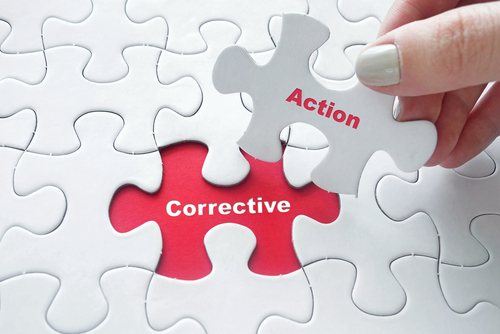Corrective Action
Corrective Action Workflows and Tracking

March 7, 2019
ISO management system standards require corrective action to address nonconformances discovered from audits or in other ways Including:
- Safety Incidents
- Customer Complaints
- Interested Party Concerns
- Unplanned Releases (Chemical Spills or other emergencies)
- Product Defects
- Supplier Quality Issues
- Employee Concerns
- A systematic workflow process for performing CA that clearly describe who does what, when.
- A way to keep track of progress as the CA moves from discovery through closure.
Corrective Action Workflows
Corrective action workflows us approval-gates and a team approach to accomplish the improvement. Each team member plays a role in the corrective action workflow:- Internal Auditors
- Team Leaders
- Assignee
Corrective Action Process Plays Script |
|
| Team Member - Who | Does What |
| Auditor | Makes a finding during an audit and reports it |
| Team Leader | Creates and assigns a CA task |
| Assignee | Identifies a quick fix (correction) to if appropriate |
| Assignee | Investigates the root cause of the problem |
| Assignee | Identifies a potential corrective action that will prevent recurrence of the nonconformity |
| Team Leader | Reviews and if appropriate approves the correction, cause analysis and the corrective action. |
| Assignee | Performs the proposed corrective action and reports to the task initiator when complete |
| Team Leader | Assigns to an auditor for verification |
| Auditor | Verifies the correction and the corrective action have been implemented and are effective |
| Team Leader | Reviews the verification evidence and close the corrective action as appropriate |
Tracking Corrective Action
Its easy to lose track of corrective actions without an organized system to determine the status of completion. The completion statues for corrective actions are as follows:- Stage 1 – New
- Stage 2 – Investigate
- Stage 3 – Perform
- Stage 4 – Verify
- Stage 5 - Close
- Not investigating the problem cause
- Identifying inappropriate corrective actions that do not solve the problem
- Losing track of the CA (fall between the chairs)
- Increasing risk by not addressing known problems in a timely fashion
- Ability to control who approves a CA to move to the next stage of completion. These can also be thought of a permissions granted to types of uses of the CA tracking system
- A way to notify team members (email or other) when something changes with the CA stage status.
- A way to search, sort and filter the CAs to quickly check for one or a group of CAs
- A dashboard and report feature to help summarize CA performance and report to leadership.
